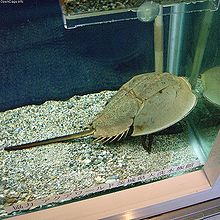Tachypleus tridentatus
| Tachypleus tridentatus | |
|---|---|

| |
| Male | |
| Scientific classification | |
| Domain: | Eukaryota |
| Kingdom: | Animalia |
| Phylum: | Arthropoda |
| Subphylum: | Chelicerata |
| Order: | Xiphosura |
| Family: | Limulidae |
| Genus: | Tachypleus |
| Species: | T. tridentatus
|
| Binomial name | |
| Tachypleus tridentatus | |
Tachypleus tridentatus, commonly known as the Chinese horseshoe crab, Japanese horseshoe crab, or tri-spine horseshoe crab, is a species of
moult.[3]
Description
Underside of male (above) and female (below) drawn and painted by Kawahara Keiga, 1823-1829. Notice the long spines on the rear carapace (six on either side in male, three in female) and the shape of the first two pairs of walking legs (hook-like in male, scissor-like in female)
Horseshoe crabs are not crabs at all, but are most closely related to
book gills are located on the underside of the opisthosoma.[6] Both the common name tri-spine horseshoe crab and the scientific name tridentatus refer to the three small spiny processes on the rear part of the opisthosoma (one spine in the middle above the tail and one on either side), while other species only have a single spine (in the middle).[7]
-
Dorsal
-
ventral
-
Face
The tri-spine horseshoe crab is the largest of the living horseshoe crab species.moults).[10]
Ecology

Like other species of horseshoe crabs, T. tridentatus is an omnivore and feeds on
molluscs, worms, other benthic invertebrates and algae.[5] Large batches of eggs are laid in holes dug in sandy beaches in special nursery areas off the coast. On hatching, the larvae remain in the nest over winter, feeding on the yolks of their eggs for several months, remaining in this nursery area during the next spring and summer. As juveniles they remain buried in the sediment during high tide, emerging at low tide to feed on the exposed surface. They have limited opportunities to disperse widely. Adults move offshore for the winter, hibernating buried in the seabed at depths of around 20 metres (66 ft), coming inshore again when the water warms up the following year. As a poikilotherm, this horseshoe crab is much affected by rising seawater temperatures, reacting by burying itself deeply in the sediment and sometimes going into diapause.[11]
Status

The tri-spine horseshoe crab are at risk from over-fishing, pollution and the loss of their breeding grounds. Populations have declined for decades, and the species was granted protection in Japan in 1928. In China it has become less common and, from being once abundant in Taiwan, it is now seldom seen inshore there. As of 2019, the
Endangered" based on recent population and habitat declines.[1]
References
- ^ a b c Laurie, K., Chen, C.-P., Cheung, S.G., Do, V., Hsieh, H., John, A., Mohamad, F., Seino, S., Nishida, S., Shin, P. & Yang, M. 2019. Tachypleus tridentatus (errata version published in 2019). The IUCN Red List of Threatened Species 2019: e.T21309A149768986. https://dx.doi.org/10.2305/IUCN.UK.2019-1.RLTS.T21309A149768986.en. Downloaded on 12 April 2021.
- ^ Boxshall, Geoff (2015). "Tachypleus tridentatus (Leach, 1819)". WoRMS. World Register of Marine Species. Retrieved 2015-08-22.
- ^ .
- PMID 30917194.
- ^ ISBN 978-81-315-0104-7.)
{{cite book}}: CS1 maint: multiple names: authors list (link - ^ ISBN 978-0-387-89959-6.
- ^ a b c "Identification guide". Horseshoe Crab monitoring site. Retrieved 26 June 2018.
- ^ "About the Species". The Horseshoe Crab. Retrieved 26 June 2018.
- ^ .
- doi:10.3354/ab00289.
- doi:10.3354/ab00194.
External links
 Media related to Tachypleus tridentatus at Wikimedia Commons
Media related to Tachypleus tridentatus at Wikimedia Commons






